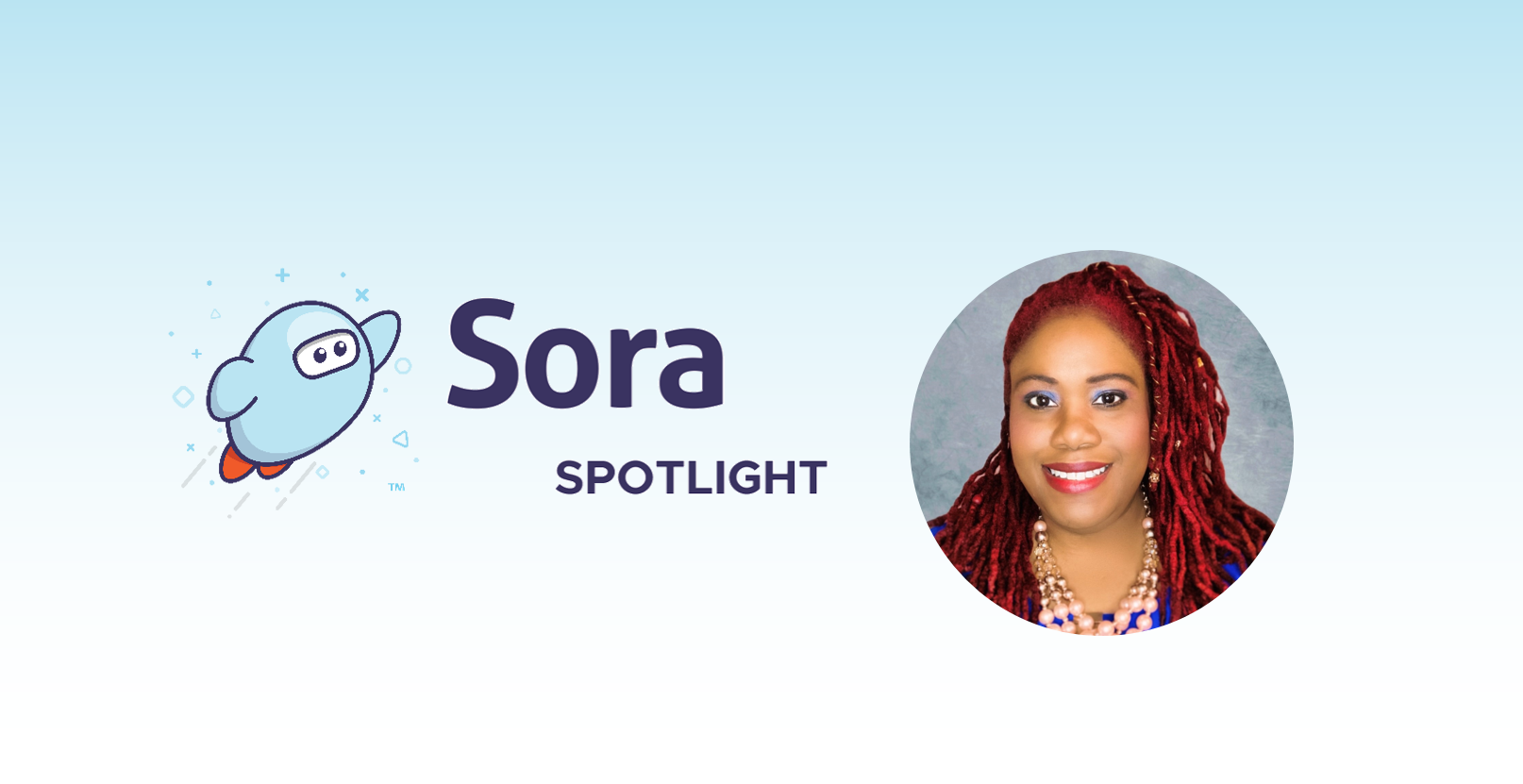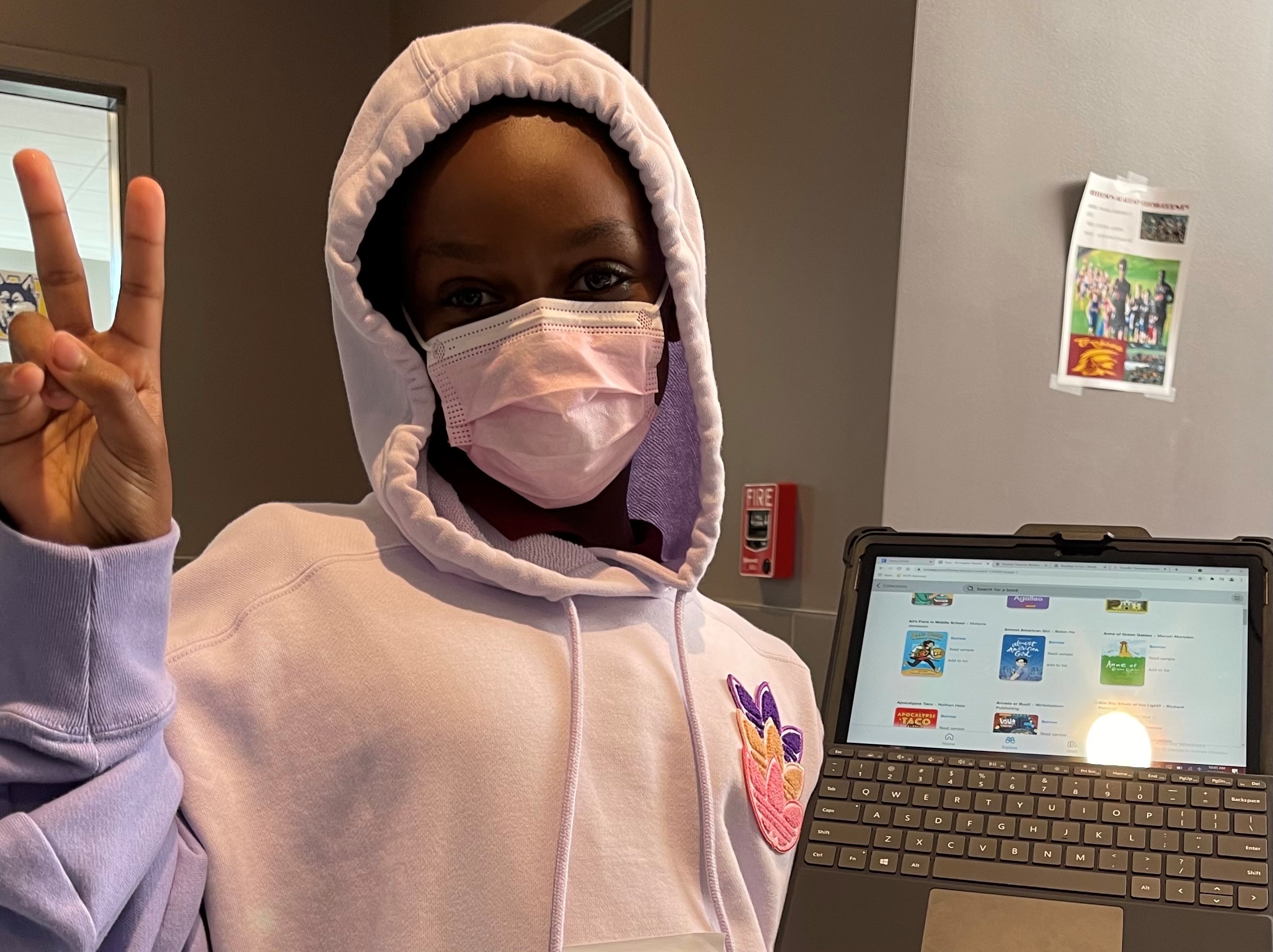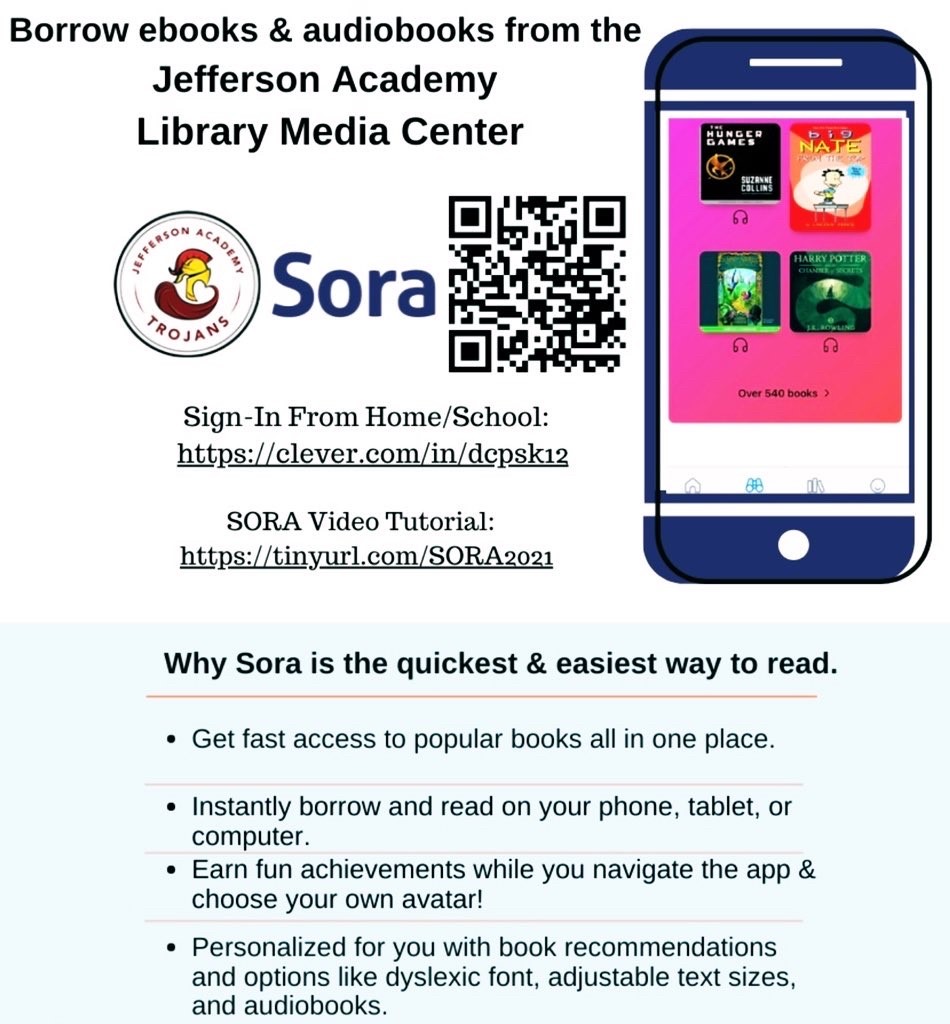
Sora Spotlight: Meet K.C. Boyd, Librarian at Jefferson Academy (District of Columbia)
In this recurring series, we’ll feature a different librarian, media specialist or educator who’s become a Sora champion at their school, impressing us with their innovative methods for implementing the reading app and engaging with their students. We’ve asked them to share their thoughts and ideas here so that we can all be inspired and identify new ways to reach students and help them fall in love with reading.
Today, we’ll hear from K.C. Boyd, a librarian at Jefferson Academy in the District of Columbia (D.C.).
 Educator Stats:
Educator Stats:
Name:
K.C. Boyd
Describe your position and your school.
I work at Jefferson Academy, which is a middle school in southwest D.C. My school serves kids in grades 6-8, with about 415 kids in the building. There are a myriad of different learners from one end of the spectrum to the next: gifted readers, low-level readers and students in between. We have about 100 IEP or 504 plans with a small autistic population.
At our school, the racial balance is very diverse. White, Black, but also, we have kids from various areas of America, the islands and West Africa. You don’t know their background until you have those conversations with them. We just finished Hispanic Heritage Month; I had the flags up and students would say, “This is my family’s flag from my homeland!” It’s fascinating and I learn a lot about different cultures from them.
This is my 24th year as a school librarian. I started in Chicago, moved to downstate Illinois, and am now in D.C. Public Schools (DCPS). I have worked with all three age groups and like middle school the best; they are the most curious.
How many years have you been active with OverDrive?
2 years
What are you currently reading?
There are so many books that I’m reading at the same time. A lot of my reading deals with understanding Washington D.C. a little better. I’m currently reading Reclamation: Sally Hemings, Thomas Jefferson, and a Descendant’s Search for Her Family’s Lasting Legacy by Gayle Jessup White. I was able to get an advanced copy and it’s interesting to hear from the family members’ perspective.
K.C.’s Sora story
What do you love most about Sora?
What I love about it is the ease of use and the availability of materials/books kids can read. It is so simple to use. Once the kids set up their portal to get into it, they just take off. It’s so much fun to watch them read and have books at their fingertips. I may not see all those kids physically check out a book in the library, but I can see they are active online, and I hear reports back form the teachers. But that’s my favorite thing, the ease of use, it’s simple to use. Not a lot of clicks.
The library department from District of Columbia Public Library and DCPS go in and curate selections and makes things even easier for us to do the work. For example, they curated Halloween stories (in October) and a lot of cooking-related books on historical facts around Thanksgiving and Veteran’s Day. It’s helpful when you are looking for some go to material with the kids. The curated material is easily created and presented in a very easy and user-friendly manner
Do you help with curation?
 Not with the district, but I have done curation for my school. I’ve created a couple of lists like JA (Jefferson Academy) Pride, JA Sports and JA Romance. I get some students who can’t find anything, and I can tell them to search under Explore and type in JA, and everything they are interested in will pop up. That’s what I do for my hard-to-please readers, because I’ve already curated and I know it’ll be easy for them to find.
Not with the district, but I have done curation for my school. I’ve created a couple of lists like JA (Jefferson Academy) Pride, JA Sports and JA Romance. I get some students who can’t find anything, and I can tell them to search under Explore and type in JA, and everything they are interested in will pop up. That’s what I do for my hard-to-please readers, because I’ve already curated and I know it’ll be easy for them to find.
Is there anything you did to kick off this school year to introduce Sora to your students?
If you want to start that introduction, do it in a face-to-face environment with a teacher present. When I did that, it made all the difference in the world for getting the kids on board with using Sora.
I want to back up further. Every year during the back-to-school meetings my principal will give each department 30 minutes to give a presentation. This year, I talked about Sora. I pointed it out to the teachers and said that our goal was to get kids to read more. One of the ways to do this is with the three Ms: modeling, motivations and move out of the way. Let the kids read whatever they want to read. If they want to read anime, romance or a book about cars, leave them alone and don’t direct them toward required reading. If we can get our kids to be excited about reading, when it comes time to do required reading, they will be more open.
Then, when school began, I said, “Invite me to your class for 12 minutes.” Twelve minutes was all I needed to get the kids set up on Sora. We are 1:1 and our students all have tablets. I did a demo for the students, and I showed them how to log on and how easy it is to read what they want to read. After, I could hear the teachers tell the students to put it away, as the kids kept wanting to read! I wanted to enforce independent reading and encourage kids to be bigger independent readers. Demonstrations face-to-face made a huge difference.
What unique things have you done to help increase student engagement with Sora?
I focus on social media and parents. I went to the OverDrive Resource Center and pulled down a pre-made flyer and flipped it to Canva. I added my picture, school logo, an explanation for getting kids onto the Sora platform and mentioned it’s free. For kids that miss class and don’t know how to get on, I did a screencast of Sora logging in for the first time and put it on the flyer too. I took a flyer out for the school newsletter for parents and teachers with this information. At open house I had all teachers text a .JPEG image to the parents with the Sora information on how to log on for free.
If a parent says, “I need to get my child engaged with reading,” just get on Sora! I include parents and teachers in the equation. Kids will come up with excuses not to read, but when you involve the parent and teacher, the excuses start going out the window and the kid starts reading.
In what ways have you utilized social media to reach your students? What is the impact of this?
Social media has been helpful. I am older than (most of) the parents and know they are big social media users, so it is helpful to reach them in this way because sometimes they don’t pay attention to formal notices.
I like to show continuity. The same image with all the information for Sora and my video tutorial that was sent to parents via text/email/newsletter is also on my social media pages. I know parents follow my Instagram, so I know that parents will see it. You may have a parent that doesn’t read the newsletter but may read my Twitter account, so they can see it that way. Whenever we have a holiday, I like to include the curated collections in messaging to the parents for the newsletter. For example, “Catch these spooky books that appear in a special collection in Sora!” And “Oh you haven’t set it up yet? Here’s the tutorial!”
I’m following the pattern of my school and they send things out with social media. I have a page on Facebook and tend to place materials there too. A couple of teachers have already had to translate material on Facebook for parents and grandparents. I know it’s going to get translated — my newsletter — in Spanish and Arabic, and eventually it will come to be the same on some social media pages, too.
In what ways has this been successful?
The parents are really pleased they have a nice resource for the kids to tap in to. That’s the biggest thing there.
At school, I’m walking down the hallway and a kid may go, “You’re taller than I thought you were!” because they always see me at the library desk. The next thing is, “I read that book on Sora and I enjoyed it”, or “If you don’t have this book in the library, do you think it’s on Sora?” and I can pull out my phone and check real quick. Guess what, it’s available and they can log in and get it. That’s a good feeling, when the kids stop you to tell you that they read a book, or they liked it. Having kindhearted conversations with the kids, they like it, they really do.
Also, Sora has made my life easier. And our numbers are high in comparison to last year; our checkouts have grown.
Get to know K.C.
What is your favorite “reading” moment with a student?
When I was working in Chicago, I had a group of high schoolers and we read Tyrell by Coe Booth together. The story is very relatable for that population of kids and the discussions that came out of that experience will stay with me for a lifetime. A lot of what they said was personal and spot-on in terms of the struggle some kids experience just to navigate life in certain neighborhoods. That was a really good book.
What advice do you have for new educators/librarians with a digital collection?
Hone in on the interests of the kids, not so much what you think they should be reading. Ask them, take polls, surveys, have lighthearted conversations with them. That’s how you build your collection. It should be based on the student body as a whole and what they are interested in. Graphic novels are hot right now, my students devour them, so I make it my business to get them exposed to them. They’re something that they like. There are some titles I don’t personally like, but because the kids are interested in them, that is what prompts me to make the effort and buy the titles. I take the “I” out of the equation and focus on the kids.
If you want to be the next Sora Spotlight, please reach out to us with a brief explanation of what you’re doing in your school and how you’re making an impact with Sora!
Interested in learning more about Sora? Join a live product walk-through to see it in action!
About the Author:
Kristen Hein is a Product Support Specialist working with schools to integrate digital into their libraries and classrooms. She herself has experience as a history teacher working with students grades 8-12 focusing on U.S. history and government. She generally spends most of her free time chasing around her hyper-active pup Romeo, hiking, practicing yoga and trying out the best Cleveland restaurants.
Check out how other educators are using Sora to increase student reading:
- Sora Spotlight: Susan Forgas from Veterans Elementary School (FL)
- Sora Spotlight: Molly Dettmann, Teacher Librarian at Norman North High School (OK)
- Sora Spotlight: Chris Haught, Media Specialist at Southwest Educational Development Center (UT)
- Sora Spotlight: Andria Morningstar-Gray from Lakeview High School (OH)
Tags In
Browse blog and media articles
Public Library Training
K-12 Library Training
